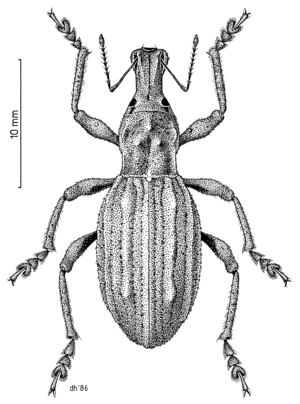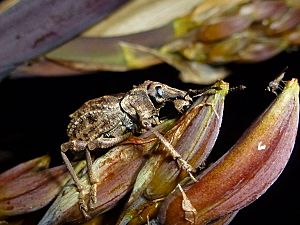Flax weevil facts for kids
Quick facts for kids Flax weevil |
|
|---|---|
 |
|
| Illustration by Des Helmore | |
| Scientific classification |
The Anagotus fairburni, also known as the flax weevil, is a large weevil that cannot fly. It likes to eat the leaves of New Zealand flax plants. When it feeds, it leaves a special notch in the leaves. You can find these weevils on islands and in high mountain areas of New Zealand.
Contents
What the Flax Weevil Looks Like
The flax weevil was first described in 1932 by a scientist named Albert E. Brookes. He studied specimens sent to him by Ernest Richard Fairburn. These weevils were found on D'Urville Island in the Marlborough Sounds.
Flax weevils are quite big and strong. They usually measure between 20 and 24 millimeters long. Their color can vary from a shiny coppery-brown to dark brown or even black. Older weevils might look black if they have lost their scales. They have special bumps, called tubercles, on their wing covers (elytra). Young weevils, called larvae, are cream-colored with a brown head. Adult flax weevils cannot fly.
Where Flax Weevils Live
This weevil lives in many different places across New Zealand. You can find it as far north as the Manawatāwhi / Three Kings Islands. It also lives as far south as Coal Island, New Zealand in Fiordland. Many populations also live on islands in the Marlborough Sounds.
Flax weevils usually live on New Zealand flax, also called harakeke (Phormium tenax). They are mostly found on islands that do not have rats or mice. They also live in high mountain areas. For example, in the Tararua Range and on islands in Tamatea / Dusky Sound, they live on mountain flax, or wharariki (Phormium colensoi). All stages of their life, from egg to adult, are found on or near flax plants.
How Flax Weevils Behave
Adult flax weevils are active at night. During the day, they hide among the dead leaves at the bottom of a flax plant. At night, they come out to feed. They make smooth, oval-shaped notches along the edges of flax leaves. These notches are rough and fibrous. This is different from the smooth notches made by the flax notch caterpillar.
Female weevils lay their eggs at the base of flax leaves. The young larvae burrow into the soft parts of the flax roots to feed. If a flax weevil is disturbed at night, it might drop to the ground. Sometimes, it will just stay very still on the leaf.
Life Cycle of the Flax Weevil
The life of a flax weevil starts as a small white egg. These eggs are laid at the base of flax plants. It takes about 3 to 5 weeks for the eggs to develop. Before the larvae hatch, the eggs turn black.
The young, yellow larvae then move towards the fan of leaves near the plant's base. They tunnel into the soft tissue inside the plant. Scientists are still learning about how long the larval and pupal stages last. Adult flax weevils have been known to live for over 12 months when kept in special care.
Protecting the Flax Weevil
The flax weevil is a protected species in New Zealand. This means it is against the law to collect, own, or harm them. This protection is under the Wildlife Act 1953.
Rats and mice are a big threat to flax weevils. These predators have caused the weevils to disappear from many areas. Now, they mostly live on islands and in mountain areas where there are no rats or mice. To help them, weevils have been moved to islands where rodents have been removed. Some of these islands include Breaksea Island, Titi Island, and Mana Island.
Studying the Flax Weevil
Usually, flax weevils do not cause much harm to flax plants. However, on Mana Island, the weevils that were moved there have caused some flax plants to become very damaged and even die. Scientists are studying the flax plants on Mana Island to understand why they might be more sensitive to weevil feeding. They are doing experiments with flax plants from different places.
Scientists also looked into whether a special fungus, called Beauveria, could help control the weevils. This fungus can infect insects. It was thought that this fungus might be missing on Mana Island, but it turns out it is already there.




